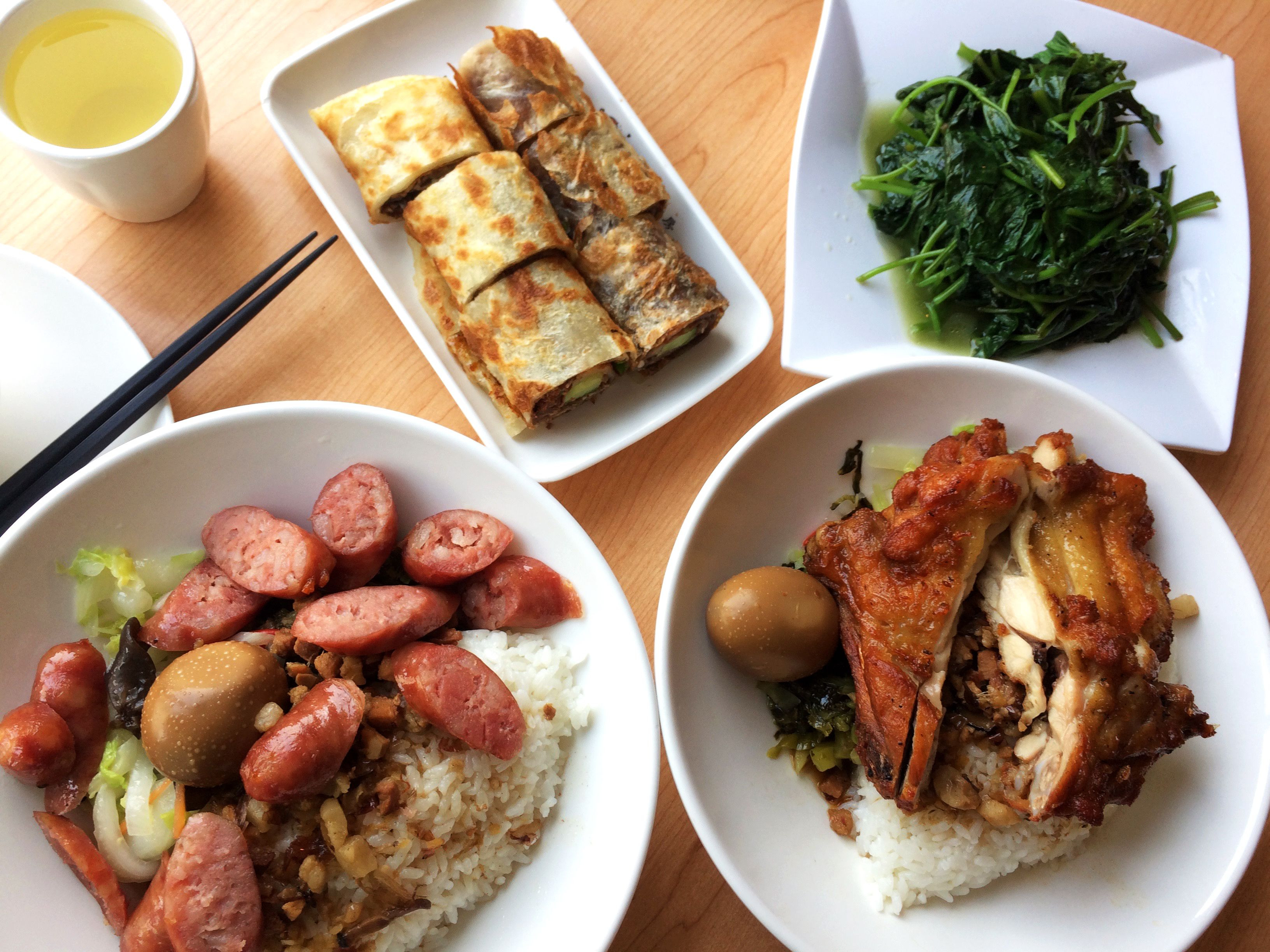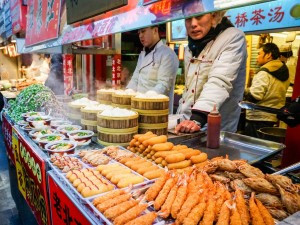How to order, buy and prepare Chinese food
“There may be no place like home,
but there’s also
no food like Chinese food”
Even when you’re no ‘foodie’, you will still be pleasantly surprised by the simplicity, diversity, creativity and utmost deliciousness of the food you will taste in China. And even better, in China it’s completely normal if you want to eat a hot meal at any part of the day. So there is a heaven after all!
The three most common ways to satisfy your hunger are:
- ordering food in a restaurant
- buying food on the street or in a shop
- preparing food yourself
In this article, I will give you some advice about those three actions when it comes to Chinese food.
1. Ordering food
 At first, you will have to find a suitable restaurant with authentic food:
At first, you will have to find a suitable restaurant with authentic food:
– Don’t apply western hygiene standards
– Don’t go for big, expensive-looking restaurants that attract foreigners
– Go to places where the locals eat
– Small, simple, (fairly) clean: perfect!
Then you will have to order the right food (more adventurous types can skip this section):
Prepare yourself:
- Search the internet for some common Chinese dishes, write them down and take your notebook with you. It can come in handy, as some restaurants require you to write down the order yourself.
- Learn the characters of some of your favorite ingredients so that you can recognize them on a menu
- Get information about regional specialties and tastes
Matters of taste
Many Chinese like to have a certain amount of spice added to their food. I was unaware of this fact until I felt the burning sensation in my mouth, and discovered there only was hot tea available to temper the heat. After this experience, I learned four words by heart to use with every next order: 不放辣椒 bùfànglàjiāo. Please don’t add spice. A request that was kindly disregarded most of the time, because ‘without, there wouldn’t be any taste to it’. And I must admit, I’ve grown to appreciate spicy food… at least to a certain degree.
If you didn’t prepare yourself, this might work:
- Ask if you can go to the kitchen and point out the ingredients you would like to have in your meal
- Ask for the specialty of the restaurant
- Choose dishes that contain words you recognize (and like to eat)
And this won’t work:
- Ask for the specialty of the restaurant (yes, this can go two ways…)
- Read the English translations on the menu (I bet the very origin of Chinglish can be traced to menu translations). Sure, they will give you a good laugh, but it won’t give you a clue about what you’re going to get on your plate.
- Remember only parts of dishes or parts of words
I will always remember this part though…
After a disastrous first encounter with a Chinese menu, I searched the Internet for the most common (and tasty) foods in China. I tried to remember most of the characters for the next day, and in particular, I remembered 腰果 yāoguǒ , cashew nut. I adore nuts! When I entered my second restaurant in China, I saw something with 腰 yāo, and thought, yeej! Nuts. Let’s do this. So I ordered the yao-stuff. That day I learned the hard way what I already had known for two years in theory: Chinese characters can have more than one meaning. No nuts but kidneys. Surprise, surprise!
2. Buying food
 Food is everywhere in China. Especially in the bigger cities, you will never have to search for a long time to find a restaurant. When traveling through China, you should be more surprised when there’s no food in your immediate surroundings. On the train, on the platforms, and even in the most remote corners of a city, you can find street vendors selling street food. There are many horror stories going around about the street food in China, and about that, there’s only one sound advice I can give you:
Food is everywhere in China. Especially in the bigger cities, you will never have to search for a long time to find a restaurant. When traveling through China, you should be more surprised when there’s no food in your immediate surroundings. On the train, on the platforms, and even in the most remote corners of a city, you can find street vendors selling street food. There are many horror stories going around about the street food in China, and about that, there’s only one sound advice I can give you:
- Only buy food that is prepared while you’re waiting. This will give you the best idea of whether it’s safe to eat or not.
- Bring your own small food container if you want to take out food. It’s a trick I learned after a strange experience in Lanzhou. But it’s also very environmentally friendly!
Food in a bag
Unlike many western restaurants, it is common for restaurants in China to offer the possibility to take out food. But if you’re expecting to get the same clean aluminum take-out containers you often get in Chinese restaurants in the West, think again. I still remember the first time I took out some noodles in Lanzhou. They gave me the noodles in… a simple plastic bag! It reminded me a bit of a really inexpensive doggy bag. It looked weird, and at first, I thought they had pulled a prank on me until I saw other Chinese students walking around with the same ‘doggy bags’ filled with noodles, steamed buns, and dumplings. Most of the time however, you will get your food in a styrofoam clamshell, which is more practical, but not very eco-friendly.
Oh, and maybe just one other tip: rely on your common sense. For instance, buying cotton candy on an ice-sculpture festival in Harbin when it’s -32°C (0°F), is not a bright idea. Unless you possess the art of eating it decently without using your fingers. I didn’t…
Just to give you an idea of what you can eat, I will give you a short (non-exhaustive) list of street foods I’ve always enjoyed while visiting China:
- 包子 bāozi: steamed stuffed bun
- 饺子jiǎozi: dumplings
- 煎饼jiānbing: thin pancake
- 酸奶 suānnǎi: yogurt (freshly made, in porcelain cups with a straw. Yum!)
- Pineapple on a stick
- Everything else on a stick (chicken skewer, cauliflower skewer, tofu skewer,…) and then fried or sautéed, with or without a piece of bread and sauces
Of course, modern China also has lots of smaller and bigger supermarkets where you can buy food. Just be aware that when there’s only one date on the packaging, it’s the production date. In some western countries, we’re used to seeing only the expiration date, and that could give you the impression that you’ve entered a shop full of expired products.
China through the eyes of a supermarket
 Most China-travellers are full of tips to how you can discover the real China on the streets, and who am I to argue with that? But personally, I got to know China through the supermarkets as well. Or at least through one supermarket: the Homeworld 家世界 supermarket in Lanzhou. While it was branded as a ‘western-style’ supermarket, it felt very foreign to me: the scale, the amount of personnel waiting at every corner, the meat & seafood department, which could easily have been the backdrop of some scary horror movie, and the bakery department, which a fellow student described to me as ‘a total mystery’, in the sense that it would attract and repulse him at the same time.
Most China-travellers are full of tips to how you can discover the real China on the streets, and who am I to argue with that? But personally, I got to know China through the supermarkets as well. Or at least through one supermarket: the Homeworld 家世界 supermarket in Lanzhou. While it was branded as a ‘western-style’ supermarket, it felt very foreign to me: the scale, the amount of personnel waiting at every corner, the meat & seafood department, which could easily have been the backdrop of some scary horror movie, and the bakery department, which a fellow student described to me as ‘a total mystery’, in the sense that it would attract and repulse him at the same time.
3. Preparing food
- Preparing Chinese food in China:
Don’t bother (it won’t be any cheaper, nor any better than anything you can find in your direct neighborhood) - Preparing western food in China:
Don’t bother (you will never find everything you need, it will always taste just that bit different and specific western products are expensive) - Preparing Chinese food when you’re not in China:
Yes! This one is worth trying.
Even if it’s just to satisfy your cravings in between your visits to China. The best way to get started is to prepare when you’re still in China: - Ask around in China, watch and learn
- Buy some authentic cookbooks in Chinese
- Practice! Cooking authentic Chinese food is not that difficult, but can still get a few attempts before you get it right. Especially those pesky dumplings can be a challenge
- Check the article for the authentic Moo Goo Gai Pan recipe.
4. Ordering Delivery
Ordering delivery in China now is pretty much everyone’s go to now. With an abundance of delivery apps including Eleme, Meituan, and of course the one and only English delivery app, Sherpa’s, delivery is no sitch now. With any cuisine that you crave delivered right to your doorstep, why make the trek into the crowded streets? A lot of times delivery in China is actually cheaper than to actually physically going to the restaurant. So when you’re feeling lazy and can’t be bothered to change out of your pajama’s, delivery will always be there for you!
My personal favorites
On my last trip to China, I bought myself some Chinese cookbooks that contained some of my favorite recipes:
- The egg-tomato dish (西红柿炒鸡蛋 xīhóngshì cháojīdàn)
- The famous 宫保鸡丁gōngbǎo jīdīng chicken with nuts
- My personal favourite鱼香茄子yúxiāngqiézi (literally fish-fragrant eggplant)
When you have the right ingredients, these are not very difficult to make. Granted, it’s not 100% the real thing, but it gets pretty close.
And after your visit to China:
- Go to a local Chinatown (if there is one) for ingredients and/or help with your cooking
- Skype or mail with Chinese friends about your failures and successes
- When this doesn’t work, you can always see if your local Chinese restaurant chef can put out some real traditional Chinese dishes for you
- And when even this fails, and you’re still craving for real Chinese food, there’s only one option left…
- Book your next trip to China!
慢慢吃!
Bon appétit!
Are you a real 吃货 (foodie) and would you like to read more about Chinese food? Check out this article on 8 Must-Try Street Food Snacks
Or even better, come to China and try them yourselves! Apply today!
by Sofie Van Breuseghem
Updated: 06/18/2019